How To Create A Simple Welcome Email Series For Your Blog
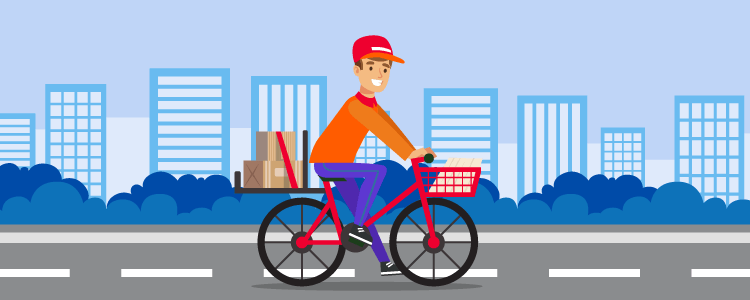
Want to boost engagement with your email subscribers? Or sell products on autopilot using email marketing?
Or maybe you want to promote your older blog posts?
All of this and more can be achieved by creating a simple welcome email series for your blog.
In this post, you will learn how to create a simple welcome email series that generates revenue and drives traffic while you sleep.
Let’s get started:
What is a welcome series and why do you need one?
A welcome series is a number of emails you send out after a new subscriber joins your email list.
It’s a strategy you automate so every new subscriber receives it.
Typically they range from 3-7 days in total. However, this will vary depending on many factors. Such as your niche, what your products or service is, or how much you want to say.
It’s your first impression: your one and only chance to draw that person in and show them why they need to be on your email list.
But why should you go to the time and effort of creating a welcome series? Take a look at these stats…
- Welcome emails generate 320% more revenue than regular emails/newsletters
- Over 74% of people expect a welcome email immediately after joining your email list
- A study done by Experian indicated welcome emails produce 4X the open rates than bulk emails
And, it will enable you to…
- Introduce yourself and your brand
- Building trust with your subscribers
- Beginning connections that’ll help your business in the long-term
- Give them a reason to stay an engaged member of your email list
- Get more results and earn more revenue
Many businesses have a welcome email. But it’s proven to be more compelling if you invest the time in an entire welcome series.
Execute it well, and you’ll have people flocking to your email list at warp speed. Where they’ll remain: engaged and active.
What should your welcome series include?
Depending on your business or blog – your welcome series may vary drastically.
However, there are some universal components to any flawless welcome series.
Email # 1
Using your favorite email marketing provider, automate the email to go out immediately after they subscribe.
The main purpose of the initial email is to introduce yourself and your business.
But it’s also your opportunity to dazzle them with your personality so they’re hooked.
They’ll likely skip the rest of your series if your first email is sub-par, so take your time with this one.
Don’t overdo it, but let them know a bit about yourself, what you do, and what you can offer them.
What you can include in email #1:
- Tell them what they can expect from you and how often you’ll be in their inbox
- Content upgrades or your lead magnet
- How you can help them and what’s in it for them
- Ask them to follow you on social media
- Give them a reason to trust you and like you
- Include social proof, where you’ve been featured, etc.
Here’s a perfect example of Moms Make Cents’ welcome email – that checks all the boxes:
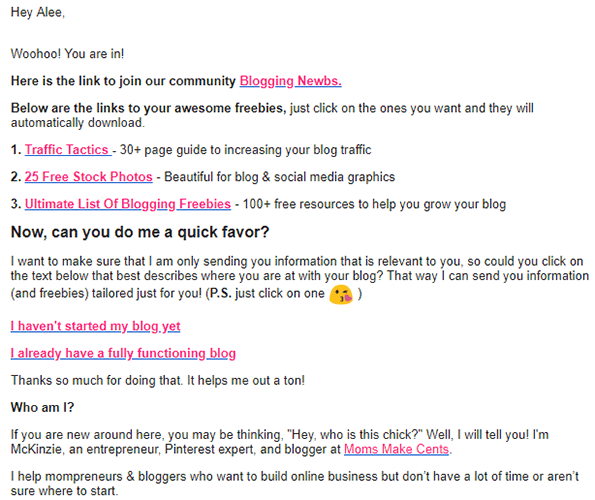
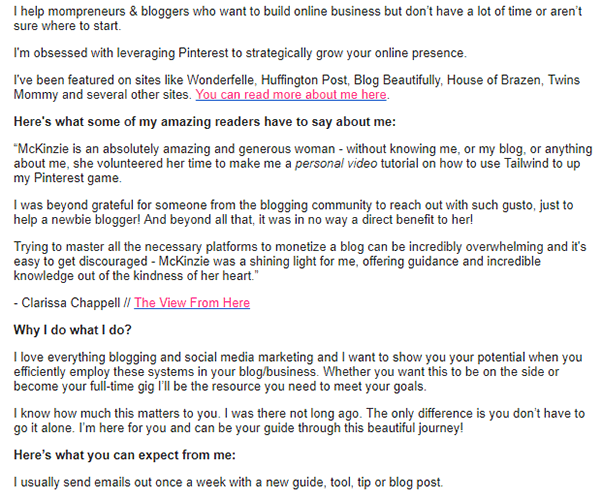
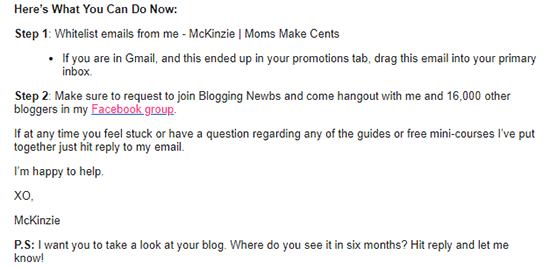
Somewhere in the first email in the series – drop a teaser of what’s to come. In the next email you’ll be providing something of value – so be sure to entice them and get them excited about next email!
Email # 2
You can send this email tche day after the first one – or 1-2 days after if you prefer.
Don’t wait too long, though.
For this email, you want to deliver on the promise you made in the last email and gather information about your new subscriber.
It’s time to take out your best stuff.
Examples of what you can offer:
- A list of (free and paid) tools and resources to help them
- A list of your most valuable and helpful blog posts
- An excellent tip or piece of advice
- An exclusive piece of content or unadvertised lead magnet
Using this email to get to know your subscribers is paramount. Start to build that meaningful connection that will come in handy later on in your series.
Ask them a question, and find out what makes them tick.
What are their pain points?
Wants?
Desires?
Struggles?
The more you can learn about your subscribers – the better.
You may not get a huge number of replies. But you’ll be surprised how many people are willing to give you a little personal information.
Email # 3
The third email can go a number of ways. You do have a bit of wiggle room to get creative as long as it’s cohesive with the rest of your welcome series.
The only component that I’d say is crucial at this stage, is giving your subscribers some insight about yourself.
Nobody enjoys a faceless brand. But if it is a massive business – you can still make it work. You’d just highlight the brand to humanize it as best you can.
The most common and effective third emails can include:
- Let them get to know you personally
- Inviting them to your social media accounts or your Facebook Group
By sharing a little piece of yourself with your readers, you become more relatable.
If you’re more relatable, you’re more trustworthy.
And as much as we genuinely want to help others in our businesses – running a business is about earning an income.
And building those real connections will help earn more revenue in the long-term.
If you haven’t already invited your new subscriber to join you on social media – now’s also the perfect time.
Email #4
Now that you’ve gone through the meat and potatoes of your series, it’s time to give them an unexpected goodie.
By this point, you’ve already blown them away with a relevant and beneficial gift. So they won’t be expecting another. It’ll help to remind them what you have to offer and why your email list stands out from the noise in their jam-packed inbox.
Giving away free content can be a strategic move on your part, contrary to popular belief.
This shows them you go above and beyond for your readers/customers, and they’ll respect you for it.
All of which will lead to gaining their trust and creating a raving and loyal fan out of them.
Email #5
Now that you’ve begun to build their trust, the goal of email five is to prod them in the direction of your paid offerings.
This could be your snazzy new e-book, your newly launched e-course, a service you offer – or any paid offering you have.
However, be subtle. And be sure to include some type of tip or hack that they’ll find beneficial.
Email #6
The moment you’ve been building up to is finally here.
While it can be downright terrifying to sell to people, it’s a necessary evil. But that doesn’t mean you have to be spammy or come off salesy.
At the same time, you want to spur them into action immediately. Because chances are, if they close your email, they’re going to forget about it.
Kate Doster perfected her email below. Where she spurred urgency to purchase her e-course:

She tells her subscribers when this paid offering will be disappearing, which sparks urgency and makes them sweat a little bit!
You can use a countdown timer at the end of this email as well. That really helps subscribers visualize how little time they have left.

Email #7
You can give yourself a pat on the back: the challenging portion of the welcome series is finished.
Take the opportunity to figure out where each subscriber should be on your email list now.
I’m talking segmentation: a highly effective way to do email marketing.
When you segment your email list, you can show content that’s relevant to that individual subscriber. Instead of sending them every email you send out.
Look at how Caitlin Bacher asks for feedback by giving a choice of links to click:
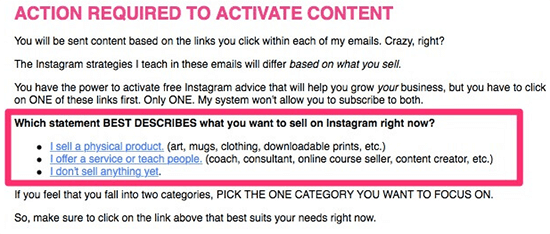
You can do the same thing to segment your list, or you can simply ask for feedback to better serve your new subscriber going forward.
Decide on your timeline
Just like the rest of your welcome email series – your timeline and frequency will differ. All depending on your individual business or brand.
Most welcome series emails last between 3-7 days. You can spread it out however you like – but it’s most common to send them consecutively. But, some marketers prefer sending them every other day.
The content in your welcome series is more important than how many emails you send. You can decide this after you come up with a solid strategy for your series, and have filled in the content.
What is vital, is getting your email series started right away. The first 48-hours after subscribing is when your subscribers will be the most active and engaged.
This is why that first email in your sequence is most critical.
Ask to be whitelisted in your welcome series
Like any email you send to your email list – you want to avoid landing smack dab in the spam filter.
An excellent approach is to be straight with your new subscriber and simply ask them to not put you there.
How?
Easy-peasy. Ask them to whitelist you, like McKinzie from Moms Make Cents did:

This is common practice when using a welcome series or welcome emails.
As strange as it may feel at first – people are used to it! I guarantee most of your competitors are asking, and getting more results because of this small tip.
And if you save it for towards the end of your welcome series, they’ll probably already be raving fans!
Make your series shine by personalizing it
There’s nothing worse than receiving a generic email that’s clearly intended for 50,000 people.
Although your subscribers are intelligent and know they’re not the only one you’re talking too – it’s still important to attempt to make them feel like they’re the only ones.
This includes talking to them in a conversational tone, even more so than in a blog post.
Talk to them as they were your friend. If you write your welcome series like you’re writing to one person, instead of your whole list – you’ll have better luck.
Every email marketing provider gives you the option to add your recipient’s name anywhere in an email, but you can also experiment by using their names in the subject lines.
You can also try using buyer personas to take your email marketing to the next level.
After all, the more you know about your subscribers and customers – the better you can serve them.
And when you know them inside and out, they’re far more likely to purchase your paid offerings.
Monitor your results and make alterations where needed
There’s no doubt that crafting a welcome series is your best bet when it comes to email marketing.
In fact, according to this study, welcome emails have the highest open rates at 50%:
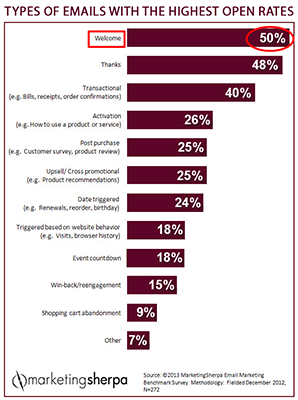
But, like any marketing strategy – it’ll eventually need alterations as your business grows.
Over time your freebies and paid products will change – among other things.
The emails will need to be adjusted, or even re-written to reflect changes that occurred over time.
Wrapping it up
Email marketing is one of the most widely used marketing channels. And it has a higher ROI than any other channel. These statistics prove it.
Creating a welcome email series is the first step in making this marketing channel work for you.
Sending out newsletters every week can work well, but you need to take things a step further.
The few days it’ll take you to craft an awe-inspiring welcome series will pay off, big-time.
Just keep in mind that no two email marketing campaigns will be the same.
While most of the components used in the examples today will work for most businesses and bloggers – you’ll likely need to fill-in-the-blanks with your own information.
To learn more about email marketing, check out Adam’s ultimate guide to building an email list.

